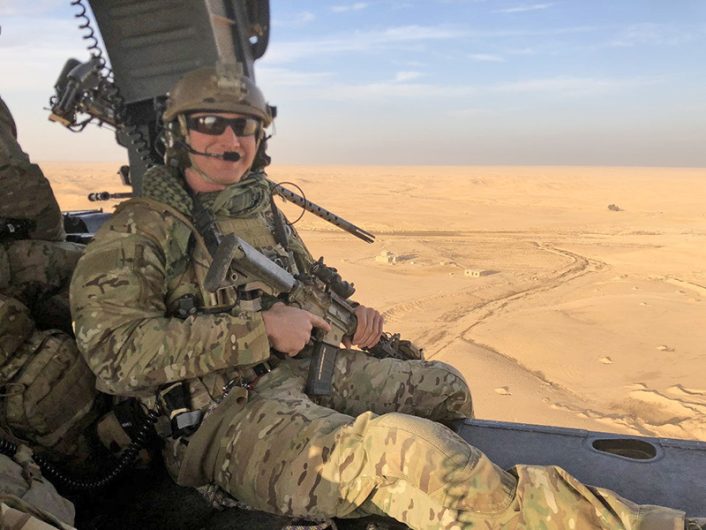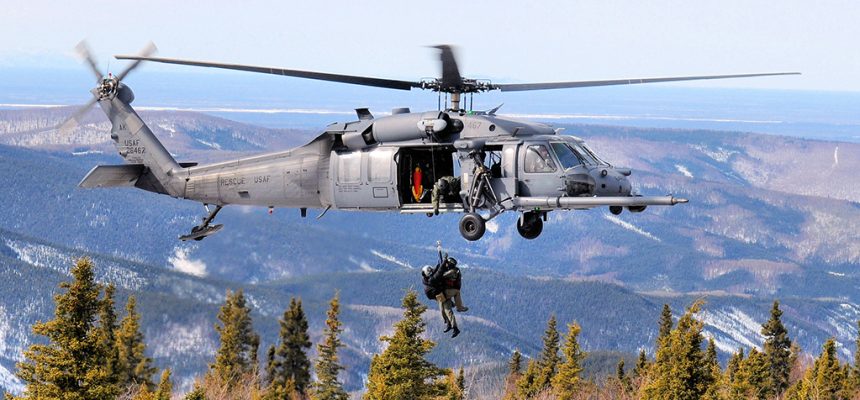A USAF HH-60 From Alaska Crashes, Crew of Seven Die Near Al-Qaim, Iraq on Thursday.
All seven crew members on board a U.S. Air Force HH-60G Pave Hawk helicopter were killed when it crashed in Iraq on Thursday, March 15, 2018. The aircraft belonged to the Alaska Air National Guard’s 176th Wing from Joint Base Elmendorf-Richardson in Alaska. None of the crew killed in the crash were from Alaska according to a report filed in the Air Force Times on Friday, March 16, by journalist Stephen Losey.
The crash occurred in Anbar Province outside Al-Qaim, Iraq on the Syrian/Iraqi border 400 kilometers northwest of Baghdad along the Euphrates River.
The cause of the crash is unknown at this time. A New York Times story published Friday, March 16, 2018 by Thomas Gibbons-Neff and Al Baker reported that, “American officials could not immediately say why the aircraft went down killing all seven service members on board, although enemy fire was not believed to be the cause.”
The HH-60G Pave Hawk is an Air Force specific version of the Blackhawk helicopter with significant modifications for the combat rescue role and it is generally regarded as the most advanced version of the aircraft. Photos of the HH-60G Pave Hawks based at the Alaska Air National Guard’s 176th Wing often show the aircraft operating in the high mountains, equipped with snow-ski landing gear. When deployed to the Middle East the aircraft uses standard landing gear. The website for the Alaska Air National Guard 176th Wing lists only one squadron, the 210th Rescue Squadron, as operating the HH-60G. The 210th Rescue Squadron lists six HH-60G Pave Hawks on their official Air Force unit page.
The Air Force Times identified one of the Airmen killed in the crash as USAF Staff Sgt. Carl Enis. Sgt. Enis was an Air Force Reserve Pararescue operator from the 308th Rescue Squadron, 920th Rescue Wing from Patrick Air Force Base in Brevard County, Florida. As a reserve Air Force Pararescueman, Enis also had a civilian career as a commercial real estate salesman in Tallahassee, Florida. He was described in media reports as, “an avid outdoorsman and devoted friend who had a knack for bringing people from different backgrounds together”.

Not all of the names of the personnel who died in Thursday’s crash have been released. USAF Central Command spokesperson Lt. Col. Damien Pickart reported via email on Friday that two of the seven airmen killed were Pararescue operators. Lt. Col. Pickart indicated the Department of Defense is expected to post the names and units of all of the airmen by Saturday afternoon.
A post did appear on the New York City Fire Department’s Facebook page saying that two of its firefighters, Christopher Zanetis and Christopher Raguso, were also killed in Thurday’s crash. Their Air Force rank was not indicated in the post.
The ABC affiliate in New York, ABC7, reported that Zanetis and Raguso and an additional two Airmen killed in the crash were members of the New York Air National Guard’s 106th Rescue Wing from Gabreski Airport in Westhampton, New York.
U.S. Air Force Pararescue units are credited with saving “over 1,000 lives in the Global War on Terror since 9/11” according to a 2011 report. During the 2005 hurricane Katrina between Florida and Texas in the United States, Air Force Pararescue operators of the 943rd Rescue Group from Davis-Monthan AFB in Tucson, Arizona were credited with rescuing 1,043 people. Air Force Pararescue is generally regarded as one of the most capable special operations units in the world specifically tasked with combat rescue operations.
Top image: File photo of USAF HH-60G Pavehawk helicopter of the 210th Rescue Squadron. (Photo: USAF)









